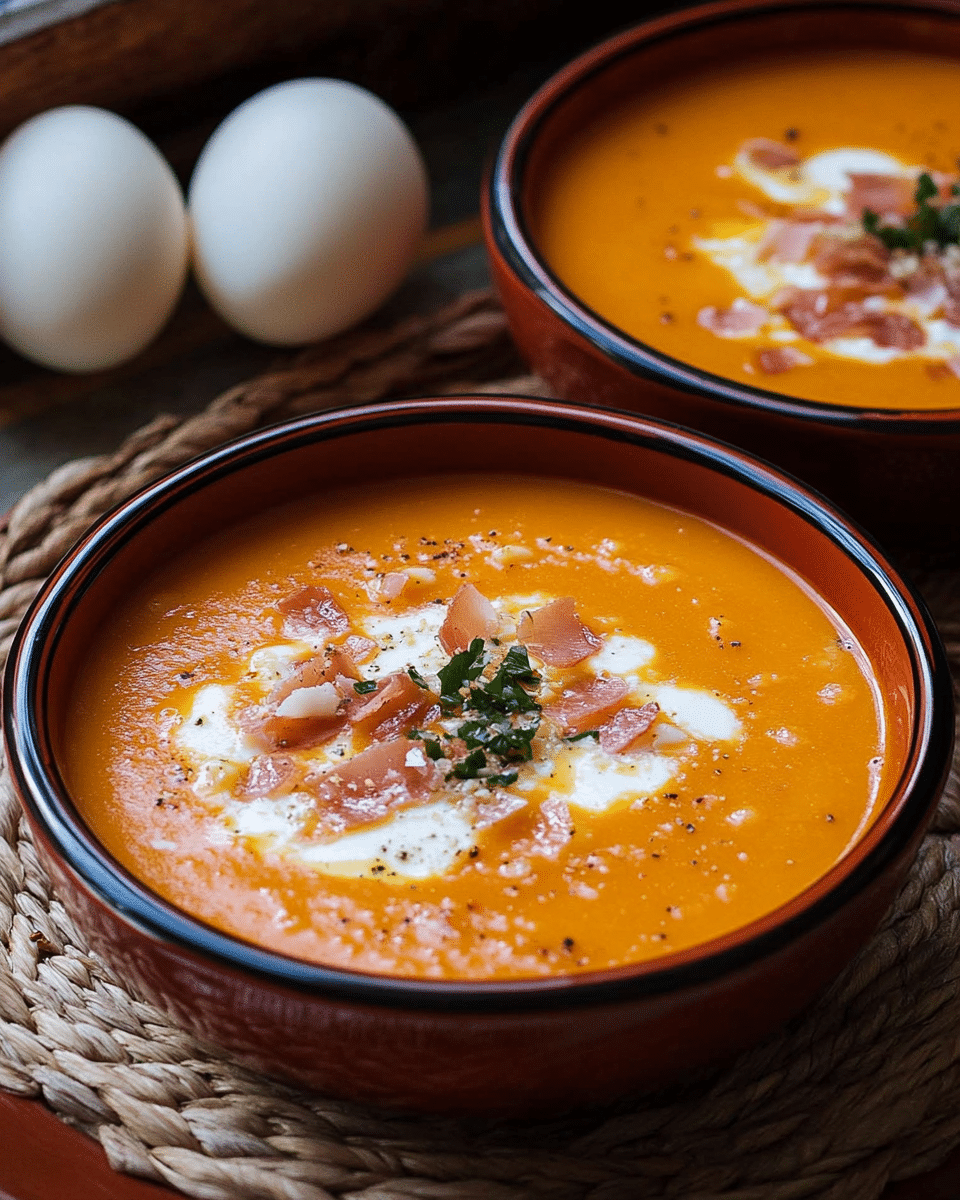The sun-drenched region of Andalusia brings us the perfect answer to hot summer days: Salmorejo. This creamy, cold tomato soup is Spain’s answer to refreshment and comfort combined. Unlike its cousin gazpacho, Salmorejo is thicker, richer, and traditionally topped with hard-boiled egg and jamón serrano. Its velvety texture is achieved by emulsifying ripe tomatoes, stale bread, olive oil, and garlic into a luxurious chilled puree.
Whether served as a light lunch, appetizer, or part of a tapas spread, Salmorejo is a flavorful dish that evokes the warmth and traditions of Southern Spain. The contrast between the silky soup and the savory toppings makes every spoonful unforgettable. Ideal for make-ahead meals or summer gatherings, this dish brings elegance and simplicity together in one beautifully chilled bowl.
Full Recipe:
Ingredients:
-
2 lbs (900g) ripe tomatoes
-
1 day-old baguette (about 7 oz / 200g), crust removed
-
1 clove garlic
-
1/2 cup (120 ml) extra virgin olive oil
-
1 tbsp sherry vinegar (or red wine vinegar)
-
Salt, to taste
-
2 hard-boiled eggs, chopped
-
2 oz (60g) Jamón serrano or prosciutto, finely chopped
Directions:
-
Wash and core the tomatoes. Cut into quarters.
-
In a blender or food processor, blend the tomatoes until smooth.
-
Tear the bread into pieces and add it to the tomato puree. Let sit for 5 minutes so the bread absorbs the juice.
-
Add garlic, vinegar, and salt. Blend again until smooth.
-
Slowly drizzle in the olive oil while blending, allowing the mixture to emulsify into a creamy consistency.
-
Chill in the refrigerator for at least 2 hours before serving.
-
Serve cold, garnished with chopped hard-boiled eggs and Jamón serrano.
Prep Time: 15 minutes | Cooking Time: 10 minutes (for eggs) | Total Time: 25 minutes + chilling time
Kcal: 280 kcal | Servings: 4 servings
Exploring the Rich Heritage and Flavor of Spanish Salmorejo
When summer heatwaves roll in, we all look for refreshing dishes that not only cool us down but also satisfy our taste buds with vibrant, seasonal flavors. Enter Salmorejo, a silky, cold tomato soup hailing from the sun-soaked region of Andalusia, Spain. Often compared to its more famous cousin, gazpacho, salmorejo offers a thicker, richer experience that is both humble in origin and elegant on the palate. Topped traditionally with chopped hard-boiled eggs and Jamón serrano, this dish is a culinary embodiment of Spanish simplicity and seasonal eating.
But salmorejo is more than just a bowl of cold soup. It is a recipe rooted deeply in tradition, tracing its history back centuries to the Roman era, evolving through time with the influence of local customs and Mediterranean ingredients. It’s a dish that tells a story, one of peasant roots, communal tables, and the clever transformation of basic staples like bread, tomatoes, and olive oil into something extraordinarily comforting.
What Is Salmorejo?
Salmorejo is a chilled purée made from ripe tomatoes, stale bread, olive oil, garlic, and salt. Unlike gazpacho, which is chunkier and often includes a medley of vegetables like cucumber, bell pepper, and onion, salmorejo is denser and creamier due to the generous use of bread and the emulsion process with olive oil.
The final result is a soup with a texture somewhere between a bisque and a mousse. It’s customarily served cold — ideal for scorching summer days and garnished with protein-rich toppings such as chopped hard-boiled eggs and thinly sliced Spanish ham (Jamón serrano or Jamón ibérico).
Origin of Salmorejo
Salmorejo comes from Córdoba, a city in southern Spain known for its Moorish architecture, white-washed buildings, and culinary riches. The dish’s humble beginnings trace back to a time when nothing went to waste, especially stale bread. Households in Andalusia would use day-old bread to create hearty meals, blending it with garden tomatoes and olive oil harvested from nearby groves.
This peasant dish gained popularity over the years and has now become a staple in Spanish households and restaurants alike. You’ll find it on menus across Spain, especially in the south, often offered as an appetizer or tapas dish during the warmer months.
What Makes Salmorejo Special?
There are several factors that make salmorejo stand out:
1. Simplicity of Ingredients
With only five base ingredients: ripe tomatoes, bread, olive oil, garlic, and salt this recipe proves that you don’t need complexity to achieve depth in flavor. The quality of these ingredients is key. Spanish cooks emphasize using sun-ripened tomatoes and good quality extra virgin olive oil, which give the soup its signature taste.
2. Creamy, Luxurious Texture
Thanks to the emulsification of olive oil and bread with the juicy tomatoes, the texture of salmorejo is rich, thick, and almost velvety. It coats the spoon in a way that feels indulgent yet refreshing.
3. Customizable Garnishes
The classic topping is hard-boiled egg and Jamón serrano, but you can also use smoked salmon, tuna, avocado, or even croutons for a vegetarian version. Each variation brings a new layer of flavor and texture.
Nutritional Benefits of Salmorejo
Salmorejo is not only delicious but also nutritious. Here’s why it’s a great addition to your summer meal plan:
-
Tomatoes are rich in antioxidants, especially lycopene, which is known for its heart health benefits and potential anti-cancer properties.
-
Olive oil offers healthy fats and anti-inflammatory compounds, making this soup heart-friendly.
-
Garlic has immune-boosting and cholesterol-lowering properties.
-
Eggs and ham (when used) add a dose of protein, making the dish more satiating.
-
Bread, though not low-carb, provides the body with needed energy and in moderation, can be part of a balanced meal.
For a healthier version, opt for whole grain or gluten-free bread, and keep the olive oil portion modest if you’re watching calories.
Serving Suggestions
Salmorejo is typically served as a starter or light lunch. Here are a few creative ways to enjoy it:
-
As a Dip: Serve it with crusty bread, crostini, or vegetable crudités.
-
In a Shot Glass: Great for tapas or party appetizers.
-
With a Side Salad: Pair with a fresh green salad or olives for a full Mediterranean experience.
-
Topped with Seafood: Chopped prawns or flakes of smoked trout make a luxurious upgrade.
-
Vegetarian Option: Swap the ham for grilled veggies or chopped nuts for added crunch.
Tips for the Best Salmorejo
-
Use very ripe tomatoes. Plum or vine-ripened tomatoes are ideal as they are less watery and more flavorful.
-
Soak the bread in tomato juice. This ensures it blends more smoothly and absorbs flavor better.
-
Chill before serving. Give the soup at least 2 hours in the fridge; it enhances the flavor and texture.
-
Emulsify slowly. Drizzle the olive oil while blending to create that signature creamy consistency.
How Salmorejo Differs from Gazpacho
Though they may seem similar at first glance, salmorejo and gazpacho differ significantly:
| Feature | Salmorejo | Gazpacho |
|---|---|---|
| Texture | Thick, creamy | Thin, more liquid |
| Ingredients | Tomato, bread, garlic, olive oil | Tomato, cucumber, pepper, onions |
| Color | Rich orange | Bright red or pinkish |
| Origin | Córdoba | Andalusia (broader) |
| Common Garnish | Egg, Jamón serrano | Diced vegetables, croutons |
Make It Ahead and Store It
Salmorejo is the perfect make-ahead dish. You can store it in an airtight container in the refrigerator for up to 3–4 days. In fact, letting it rest overnight often enhances the flavor. Just stir well before serving and refresh the garnish to keep it looking its best.
You can also freeze salmorejo without the toppings. Thaw it in the refrigerator and re-blend to restore its creamy texture.
Pairing Ideas
To make it a full meal, consider pairing salmorejo with:
-
A glass of dry Spanish sherry or Albariño white wine
-
Toasted garlic bread or rustic sourdough slices
-
A side of grilled vegetables or a light cheese plate
-
Spanish tapas like patatas bravas, tortilla española, or olives
Conclusion
Salmorejo is a shining example of how humble ingredients can be transformed into something extraordinary. This cold tomato soup not only cools the body during hot summer days but also brings a taste of Southern Spain to your table. Its creamy texture, rich tomato flavor, and savory toppings make every spoonful a celebration of simplicity and tradition.
Whether you’re hosting a Spanish-themed dinner, prepping for a picnic, or just craving a light and flavorful dish, salmorejo deserves a spot in your culinary rotation. It’s easy to make, beautiful to present, and endlessly adaptable to suit your dietary preferences or pantry availability.
So next time the temperatures rise, skip the stove and embrace the cool, creamy comfort of salmorejo, a dish where rustic charm meets gourmet elegance.






